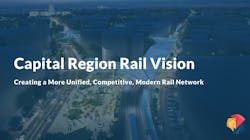Capital Region Rail Vision’s technical report provides clear path to transform regional rail network
The final elements of the Capital Region Rail Vision were released by the Greater Washington Partnership, with support from EY, Gensler, VHB, WSP and key regional stakeholders, that will help the region coordinate the delivery of a transformed regional rail network over the next 25 years.
With the release of the Rail Vision’s Technical Report, Economic Impact Brief, Equity Analysis Mapping Experience and a Rider and Redeveloped Station Experience, the region has the tools it needs to move forward and work together to realize the long-held idea of an integrated and greatly expanded regional rail network.
“The rail system in the Capital Region has untapped potential, and with today’s release, the region has the thought capital needed to move forward with a strategy to provide seamless, all-day connection across the Potomac River,” said Matt Kelly, CEO of JBG SMITH and Greater Washington Partnership board member. “It is now on the region’s elected leaders, rail agencies, businesses and advocates to work together to make this vision a reality.”
“In developing the Capital Region Rail Vision, we witnessed what can happen when the talent and leaders from around the region come together to answer the tricky questions and establish a shared vision for the region to build upon,” said JB Holston, CEO of the Greater Washington Partnership. “The collaborative effort spanned borders and politics, and we are encouraged that this spirit of unity will remain as we move to push forward on key plans and investments that will transform the regional rail system.”
The Rail Vision’s publications released today include:
- A Technical Report that establishes a more detailed roadmap of the key components that underpin the vision’s outcomes and benefits, describes key barriers to realization and strategies to address them, articulates the steppingstones toward major service enhancements and charts a five-year action plan to deliver near term wins that will enable long term success.
- A Rail Vision Economic Impact Brief that found that the vision’s capital investments could lead to more than $40 billion in gross economic output for the region, supporting upwards of 200,000 jobs in worker-years over 25 years, and, once complete, could support more than 5,000 ongoing jobs and lead to an increase of over $1.3 billion in annual gross economic output.
- An Equity Analysis Mapping Experience that examines existing jobs, housing and residential populations near the regional rail network, disaggregated by race, income and access to transportation options.
- A Rider and Redeveloped Regional Rail Station Experience that brings to life the Rail Vision’s potential at a personal level with illuminating imagery and real-life story maps.
“From transit to highways, our partners understand the importance of regional collaboration as we work together to deliver transportation improvements across the National Capital Region, with strong, reliable connections for systems serving the entire East Coast,” said Greg Slater, Maryland Secretary of Transportation. “I look forward to reviewing how the Capital Region Rail Vision dovetails with Maryland’s first 50-year Statewide Transit Plan that will provide a long-term vision and framework for coordinated transit service in Maryland.”
“The commonwealth is working to finalize unique multilateral agreements with CSX, Amtrak and VRE to launch Transforming Rail in Virginia. When leveraged with other capital investments, these assets will unlock the extraordinary potential for greater regional connectivity,” said Shannon Valentine, Virginia Secretary of Transportation. “United, we can achieve the Capital Region Rail Vision, improving access to transportation and delivering more seamless mobility for our residents, families, and employers.”
The Greater Washington Partnership, along with the region’s stakeholders, are working to meaningfully advance key elements of the Vision’s five-year Action Plan, including projects like the B&P Tunnel, Washington Union Station, Long Bridge, the Transforming Rail in Virginia program, corridor studies and the creation of a Capital Region Rail Coordinating Convening aimed at establishing a predictable venue to collaborate on shared plans and joint investments for the region. With the completion of the Rail Vision, the region has a roadmap to overcome key barriers to progress, a clear presentation of the steppingstones that will deliver major service enhancements, and the action plan needed to deliver near term wins that will enable long term success. Together, the region’s leaders are moving to implement the vision to improve the region’s economic competitiveness and resiliency, expand access to more affordable housing and walkable communities and provide for a more inclusive and connected region for all families.
The Rail Vision was developed with support and leadership by: Alexandria Vice Mayor Elizabeth Bennett-Parker; former Fairfax County Chairman of the Board of Supervisors Sharon Bulova; Maryland Delegate Jared Solomon; Prince George’s County Councilmember Dannielle Glaros; and leaders from Amazon; Amtrak; Baltimore Metropolitan Council (BMC); Brotherhood of Locomotive Engineers and Trainmen (BLET); BWI Business Partnership, Coalition for Smarter Growth; District Department of Transportation; Federal City Council; George Washington Regional Commission; Greater Baltimore Committee; Greater Washington Board of Trade; JBG SMITH; Johns Hopkins University; Maryland Transit Administration (MTA); Metropolitan Washington Council of Governments (MWCOG); Northern Virginia Chamber of Commerce; Northern Virginia Transportation Commission (NVTC); Potomac and Rappahannock Transportation Commission (PRTC); Union Station Redevelopment Corporation (USRC); Virginia Department of Rail & Public Transportation (DRPT); Virginia Railway Express (VRE); and Washington Metropolitan Area Transit Authority (WMATA).
The Greater Washington Partnership and the project team, comprising experts from EY, VHB, and WSP, have worked with these regional leaders over the last nine months to create the Rail Vision and this publications.


